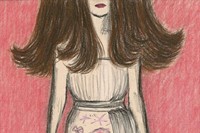The spring/summer 2012 collections were obsessed with a sort of rigid fluidity, or softness made structural, in keeping with the slightly uptight romantic aesthetic that many designers leaned toward. This was not a nostalgic tick, but an update of
The spring/summer 2012 collections were obsessed with a sort of rigid fluidity, or softness made structural, in keeping with the slightly uptight romantic aesthetic that many designers leaned toward. This was not a nostalgic tick, but an update of traditionally naïve and feminine clothing, and the way of making that modern, designers seemed to agree, was with pleating.
Whether tight accordion folds, or wider and more supple box variations, pleats gave backbone to the prettiest of summer dresses. Not only do they give loose, warm weather silhouettes an added sense of construction, they also neatly blended the season’s two main tropes of modern minimalism and classic prettiness, by giving edge and dimension.
At Versace, body-con mini-dresses in neoprene and with leather detailing, were at once softened and structured by the addition of pleated panels on the bodice and falling from the waist like panniers. These subtly crimped swags of silk moved with the body and gave interest; they competed with the almost saccharinely adorable mermaid and seahorse prints, making them formal somehow – taking them from nursery prints to cocktail hour apparently, seamlessly.
Miuccia Prada meanwhile used pleats as part of a characteristic dichotomy: while they added volume and body to classic and feminine, almost 50s-line skirts, they also ensured these were streamlined and unfussy, in contrast to the appliqué rocheted coats they were worn with. Even when paired with a similarly pleated chiffon blouses, the effect was sleek and understated.
This is the power of pleating, as discovered by Fortuny and expanded by Issey Miyake, both known for their work with ruched and scientifically scrunched fabrics. Fortuny’s flat-cut, pleated Delphos shift dress became one of fashion’s first patents, through the method of drying folded silk on heated porcelain, so that it held its pleats tightly and skimmed the body in a sensuous but naturalistic way. These gowns were the first instance of convenience clothing, and simply need rolling and knotting to maintain their crispness.
The Delphos also rendered redundant the sartorial scaffolding of Edwardian undergarments, allowing women an unprecedented freedom of movement. This is the philosophy behind Miyake’s pleated pieces too: focussing on the concept of "ma", the space between clothing and the body, the Japanese designer’s pleated pieces – in fact a whole line of them called "Pleats Please" – are articulated integrally, creating form from fluidity and vice versa. This was key to Haider Ackermann’s spring collection too. Known for his use of drapery to create volume and added dimension, Ackermann’s pleated silver lame finale gown was a synthesis of the sleekness and softness for which he has become known. And Roberto Cavalli’s use of pleats also spoke of the illusion of form: pleats encrusted with gold paillettes parted as models strode to reveal inner folds decorated with animal prints.
Pleats guarantee a silhouette and form; they are indelibly pressed into a piece, while draping is less reliably consistent and prone to differ with each wearer. This season’s pleats, meanwhile, may look all a-flutter, but they’re sturdier than they seem. And that is the whole point.
Harriet Walker is a fashion writer at The Independent. Her book Less is More: Minimalism in Fashion is out now, published by Merrell. Zoë Taylor has appeared in Le Gun, Bare Bones, Ambit and Dazed & Confused. She is currently working on her third graphic novella and an exhibition.


